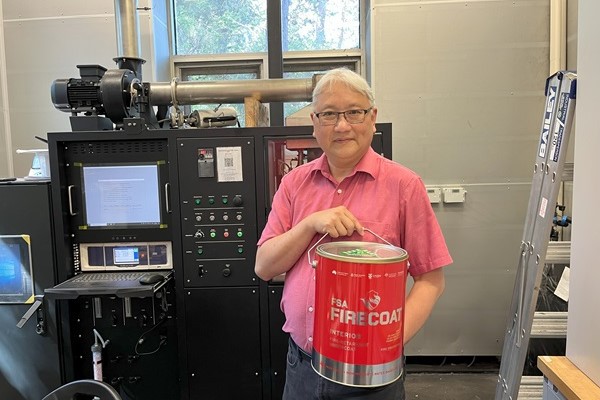UNSW Sydney develops first fire-retardant paint for extreme fire protection

UNSW Sydney engineers have developed the first fire-retardant paint to pass a stringent Australian standard test that simulates a bushfire attack.
The paint, now on sale at selected Bunnings stores, achieved the Bushfire Attack Level (BAL) 40 standard which assesses the bushfire resistance of buildings and construction materials.
BAL-40 indicates that a building or material has been tested and approved to withstand higher levels of radiant heat (up to 40kW/m²) and ember attack during a bushfire, and therefore provides increased protection against bushfires in areas prone to extreme fire conditions.
“The special additives we include in the paint mix formula promote the growth of the char which is the important insulating element. The char is what helps the substrate, that is your house or your building, stay protected from the fire,” UNSW director of the ARC Training Centre for Fire Retardant Materials and Safety Technologies professor Guan Heng Yeoh says.
“In the rigorous tests, you can see this char being created, but at the end, you can just wipe it away and the wood underneath has virtually no damage.”
Yeoh and his team spent nearly five years perfecting the formula to ensure the paint incorporates the best fire-retardant properties. The new paint, commercially branded as FSA FIRECOAT, was developed at UNSW in partnership with Flame Security International. It was partially funded via a $3 million Cooperative Research Centres Projects (CRC-P) grant from the Australian government.
Flame Security International commended the strong collaborative research partnership established and the successful outcomes of fire safety products achieved, particularly through the support of the Cooperative Research Centre project (CRC-P) Round 5 grant with UNSW.
“The release of this fully accredited BAL-40-rated fire-retardant paint, we believe, will better protect buildings and other assets from direct exposure to flames and extreme radiant heat. This will make a significant difference not only to the cost of building in affected areas but also the potential risks to life and property,” Flame Security International chief executive officer Tony Overstead says.
One of the big advantages of the new paint is that it does not need any special equipment to apply it, meaning it can be brushed or sprayed onto a variety of surfaces, including existing render, timber, aluminium, steel, concrete, plasterboard and brick, in the same way as normal paint.
To pass the BAL-40 test, an external windowed building facade was treated with the paint and exposed to the flame attack of a BAL-40 furnace for ten minutes. FSA FIRECOAT paint was applied as a primer and undercoat paint, before a standard commercial Dulux topcoat was added.
The facade consisted of timber weatherboard, specifically radiata pine which is the most combustible and commonly used timber in Australia. FSA FIRECOAT paint was applied as a primer and undercoat paint, before a standard commercial Dulux topcoat was added.
The paint succeeded in passing all six of the stringent criteria, the first time any paint has achieved the BAL-40 rating.
The carbon ingredient means the FSA FIRECOAT product is only available in grey, but any standard coloured topcoat can be applied without affecting the fire-retardant properties.
